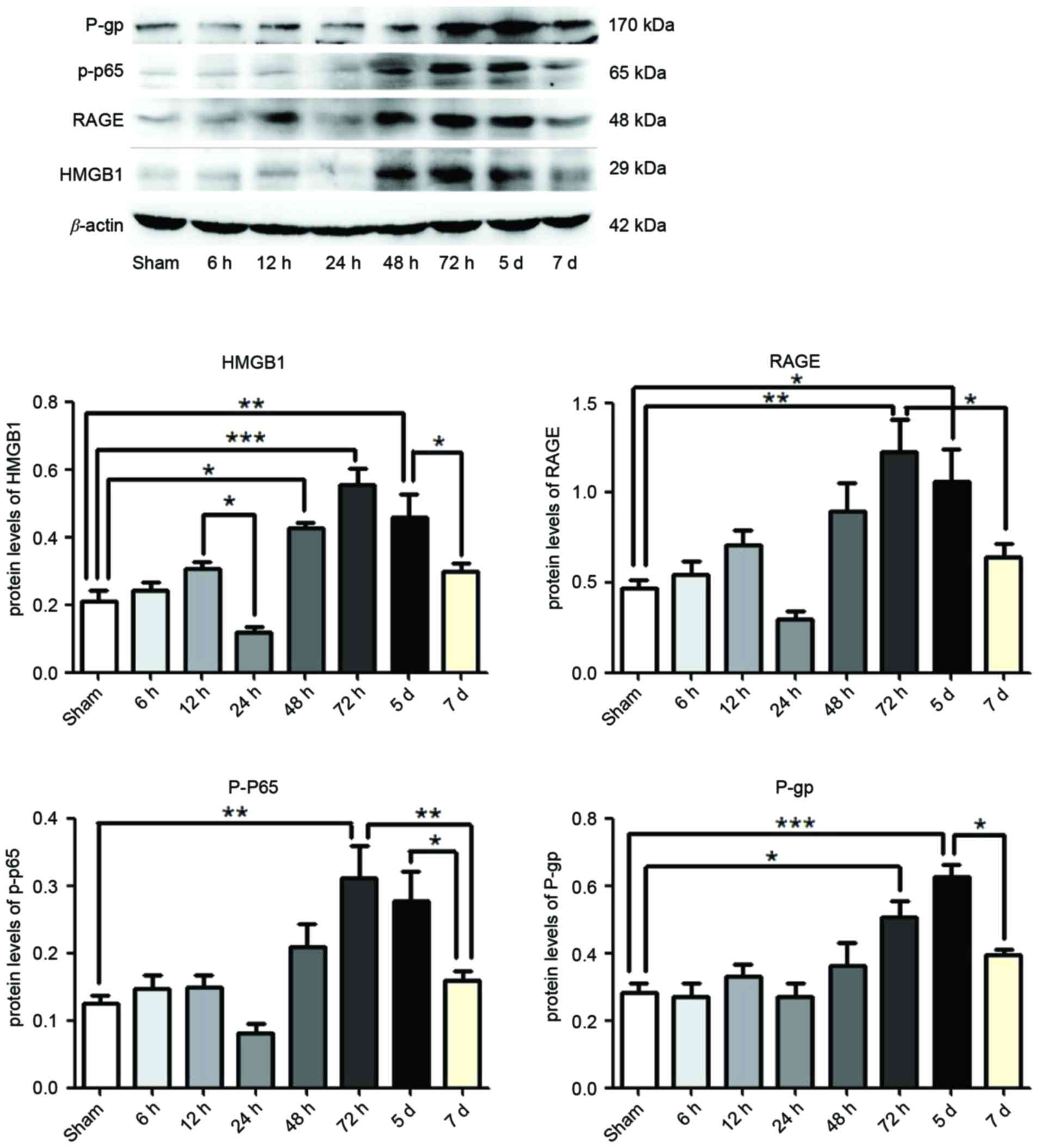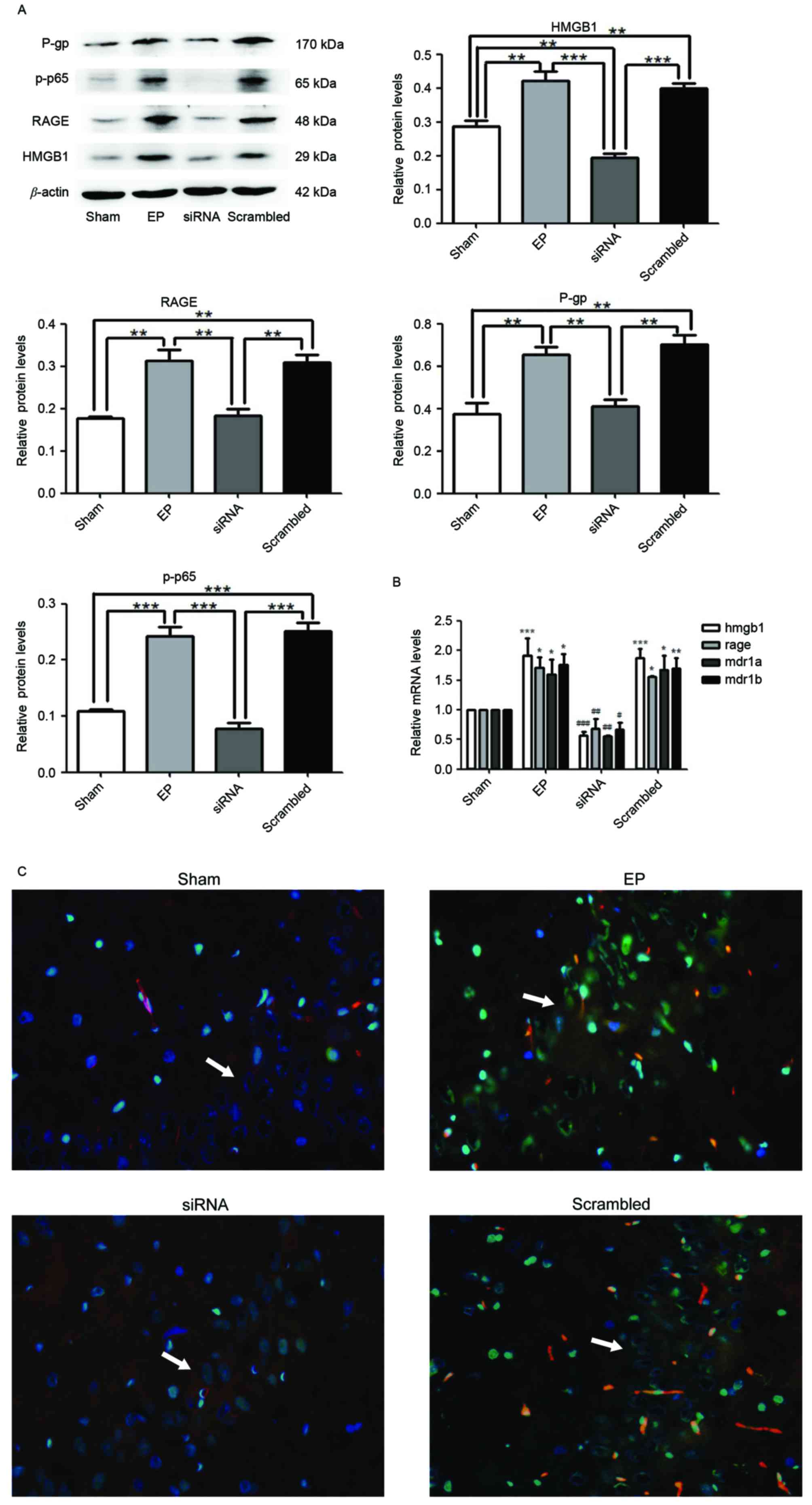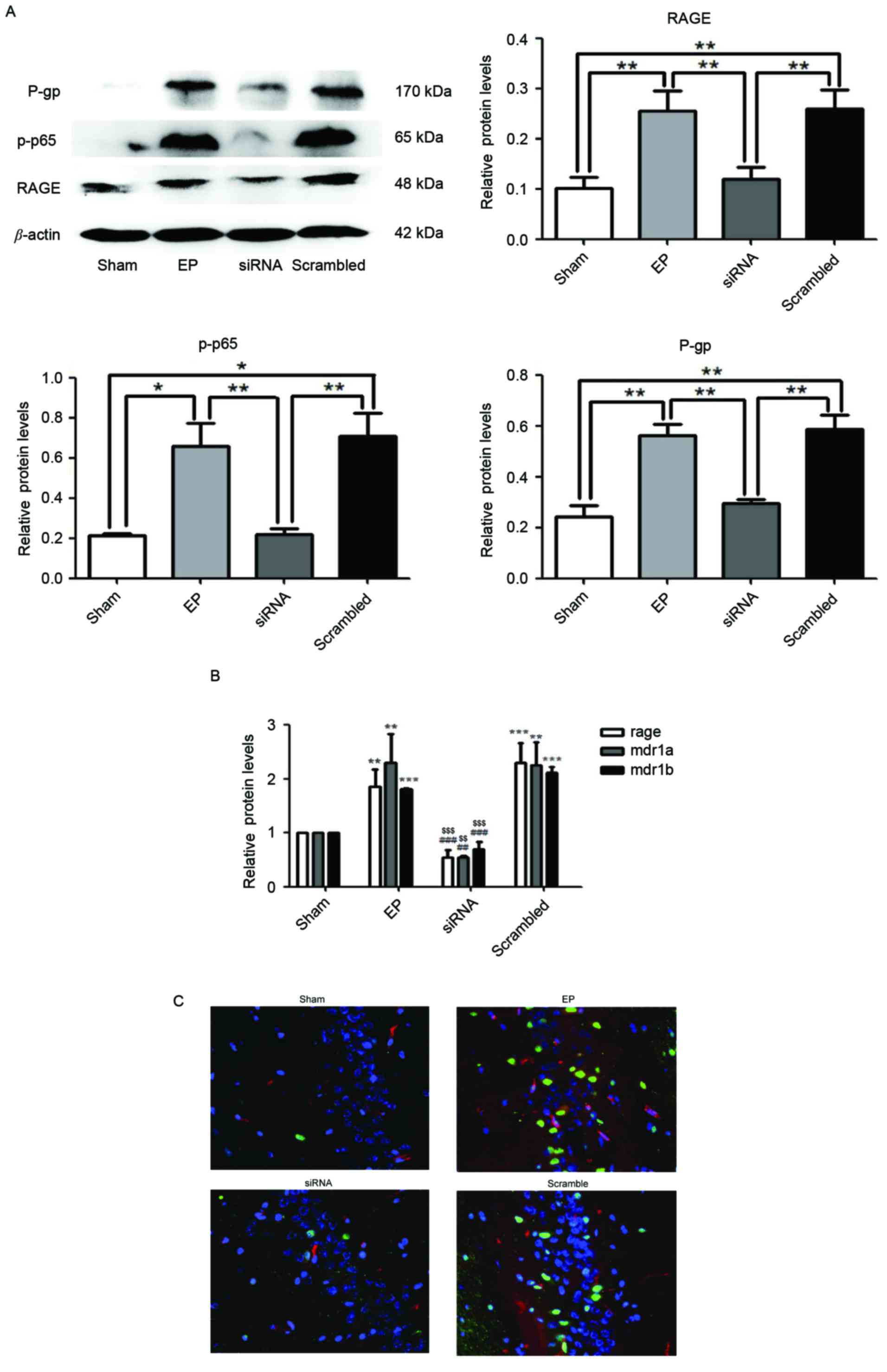|
1
|
Ngugi AK, Bottomley C, Kleinschmidt I,
Sander JW and Newton CR: Estimation of the burden of active and
life-time epilepsy: A meta-analytic approach. Epilepsia.
51:883–890. 2010. View Article : Google Scholar : PubMed/NCBI
|
|
2
|
Ni H, Sun Q, Tian T, Feng X and Sun BL:
Long-term expression of metabolism-associated genes in the rat
hippocampus following recurrent neonatal seizures and its
regulation by melatonin. Mol Med Rep. 12:2727–2734. 2015.PubMed/NCBI
|
|
3
|
Stepień KM, Tomaszewska J and Czuczwar SJ:
The multidrug transporter P-glycoprotein in pharmacoresistance to
antiepileptic drugs. Pharmacol Rep. 64:1011–1019. 2012. View Article : Google Scholar : PubMed/NCBI
|
|
4
|
Zhang CB, Kwan P, Zuo Z and Baum L: The
transport of antiepileptic drugs by P-glycoprotein. Adv Drug Deliv
Rev. 64:930–42. 2012. View Article : Google Scholar : PubMed/NCBI
|
|
5
|
Avemary J, Salvamoser JD, Peraud A, Rémi
J, Noachtar S, Fricker G and Potschka H: Dynamic regulation of
P-glycoprotein in human brain capillaries. Mol Pharm. 10:3333–3341.
2013. View Article : Google Scholar : PubMed/NCBI
|
|
6
|
Potschka H and Luna-Munguia H: CNS
transporters and drug delivery in epilepsy. Curr Pharm Des.
20:1534–1542. 2014. View Article : Google Scholar : PubMed/NCBI
|
|
7
|
Bartels AL, de Klerk OL, Kortekaas R, de
Vries JJ and Leenders KL: 11C-verapamil to assess P-gp function in
human brain during aging, depression and neurodegenerative disease.
Curr Top Med Chem. 10:1775–1784. 2010. View Article : Google Scholar : PubMed/NCBI
|
|
8
|
Holtman L, van Vliet EA, Edelbroek PM,
Aronica E and Gorter JA: Cox-2 inhibition can lead to adverse
effects in a rat model for temporal lobeepilepsy. Epilepsy Res.
91:49–56. 2010. View Article : Google Scholar : PubMed/NCBI
|
|
9
|
Hartz AM, Notenboom S and Bauer B:
Signaling to P-glycoprotein-A new therapeutic target to treat
drug-resistant epilepsy? Drug News Perspect. 22:393–397. 2009.
View Article : Google Scholar : PubMed/NCBI
|
|
10
|
Vezzani A, French J, Bartfai T and Baram
TZ: The role of inflammation in epilepsy. Nat Rev Neurol. 7:31–40.
2011. View Article : Google Scholar : PubMed/NCBI
|
|
11
|
Kawase A, Norikane S, Okada A, Adachi M,
Kato Y and Iwaki M: Distinct alterations in ATP-Binding cassette
transporter expression in liver, kidney, small intestine, and brain
in adjuvant-induced arthritic rats. J Pharm Sci. 103:2556–2564.
2014. View Article : Google Scholar : PubMed/NCBI
|
|
12
|
Doorduin J, de Vries EF, Dierckx RA and
Klein HC: P-glycoprotein activity in the blood-brain barrier is
affected by virus-induced neuroinflammation and antipsychotic
treatment. Neuropharmacology. 85:548–553. 2014. View Article : Google Scholar : PubMed/NCBI
|
|
13
|
Rojas A, Jiang JX, Ganesh T, Yang MS,
Lelutiu N, Gueorguieva P and Dingledine R: Cyclooxygenase-2 in
epilepsy. Epilepsia. 55:17–25. 2014. View Article : Google Scholar : PubMed/NCBI
|
|
14
|
Maroso M, Balosso S, Ravizza T, Liu J,
Aronica E, Iyer AM, Rossetti C, Molteni M, Casalgrandi M, Manfredi
AA, et al: Toll-like receptor 4 and high-mobility group box-1 are
involved in ictogenesis and can be targeted to reduce seizures. Nat
Med. 16:413–419. 2010. View
Article : Google Scholar : PubMed/NCBI
|
|
15
|
Chiavegato A, Zurolo E, Losi G, Aronica E
and Carmignoto G: The inflammatory molecules IL-1β and HMGB1 can
rapidly enhance focal seizure generation in a brain slice model of
temporal lobe epilepsy. Front Cell Neurosci. 8:1552014. View Article : Google Scholar : PubMed/NCBI
|
|
16
|
Chen Y, Huang XJ, Yu N, Xie Y, Zhang K,
Wen F, Liu H and Di Q: HMGB1 contributes to the expression of
P-glycoprotein in mouse epileptic brain through Toll-like receptor
4 and receptor for advanced glycation end products. PLoS One.
10:e01409182015. View Article : Google Scholar : PubMed/NCBI
|
|
17
|
Iori V, Maroso M, Rizzi M, Iyer AM,
Vertemara R, Carli M, Agresti A, Antonelli A, Bianchi ME, Aronica
E, et al: Receptor for advanced glycation endproducts is
upregulated in temporal lobe epilepsy and contributes to
experimental seizures. Neurobiol Dis. 58:102–114. 2013. View Article : Google Scholar : PubMed/NCBI
|
|
18
|
Roberts DJ and Goralski KB: A critical
overview of the influence of inflammation and infection on
P-glycoprotein expression and activity in the brain. Expert Opin
Drug Metab Toxicol. 4:1245–1264. 2008. View Article : Google Scholar : PubMed/NCBI
|
|
19
|
Yu N, Liu H, Zhang YF, Su LY, Liu XH, Li
LC, Hao JB, Huang XJ and Di Q: Effects of brain IKKβ gene silencing
by small interfering RNA on P-Glycoprotein expression and brain
damage in the rat kainic acid-induced seizure model. CNS Neurol
Disord Drug Targets. 13:661–672. 2014. View Article : Google Scholar : PubMed/NCBI
|
|
20
|
Angelo MF, Aguirre A, Avilés Reyes RX,
Villarreal A, Lukin J, Melendez M, Vanasco V, Barker P, Alvarez S,
Epstein A, et al: The proinflammatory RAGE/NF-κB pathway is
involved in neuronal damage and reactive gliosis in a model of
sleep apnea by intermittent hypoxia. PLoS One. 9:e1079012014.
View Article : Google Scholar : PubMed/NCBI
|
|
21
|
Batkulwar KB, Bansode SB, Patil GV,
Godbole RK, Kazi RS, Chinnathambi S, Shanmugam D and Kulkarni MJ:
Investigation of phosphoproteome in RAGE signaling. Proteomics.
15:245–259. 2015. View Article : Google Scholar : PubMed/NCBI
|
|
22
|
Senn C, Hangartner C, Moes S, Guerini D
and Hofbauer KG: Central administration of small interfering RNAs
in rats: A comparison with antisenseoligonucleotides. Eur J
Pharmacol. 522:30–37. 2005. View Article : Google Scholar : PubMed/NCBI
|
|
23
|
Sun H, Wu H, Yu X, Zhang G, Zhang R, Zhan
S, Wang H, Bu N, Ma X and Li Y: Angiotensin II and its receptor in
activated microglia enhanced neuronal loss and cognitive impairment
following pilocarpine-induced status epilepticus. Mol Cell
Neurosci. 65:58–67. 2015. View Article : Google Scholar : PubMed/NCBI
|
|
24
|
Racine RJ: Modification of seizure
activity by electrical stimulation. II. Motor seizure.
Electroencephalogr Clin Neurophysiol. 32:281–294. 1972. View Article : Google Scholar : PubMed/NCBI
|
|
25
|
Lei C, Lin S, Zhang C, Tao W, Dong W, Hao
Z, Liu M and Wu B: Activation of cerebral recovery by matrix
metalloproteinase-9 after intracerebral hemorrhage. Neuroscience.
230:86–93. 2013. View Article : Google Scholar : PubMed/NCBI
|
|
26
|
Soerensen J, Pekcec A, Fuest C, Nickel A
and Potschka H: Pyrrolidine dithiocarbamate protects the piriform
cortex in the pilocarpine status epilepticus model. Epilepsy Res.
87:177–183. 2009. View Article : Google Scholar : PubMed/NCBI
|
|
27
|
Livak KJ and Schmittgen TD: Analysis of
relative gene expression data using real-time quantitative PCR and
the 2(−Delta Delta C(T) Method. Methods. 25:402–408. 2001.
View Article : Google Scholar : PubMed/NCBI
|
|
28
|
Liu C, Cui Z, Wang S and Zhang D: CD93 and
GIPC expression and localization during central nervous system
inflammation. Neural Regen Res. 9:1995–2001. 2014.PubMed/NCBI
|
|
29
|
Turski WA, Cavalheiro EA, Schwarz M,
Czuczwar SJ, Kleinrok Z and Turski L: Limbic seizures produced by
pilocarpine in rats: Behavioural, eletroencephalographic and
neuropathological study. Behav Brain Res. 9:315–335. 1983.
View Article : Google Scholar : PubMed/NCBI
|
|
30
|
Choy M, Dubé CM, Patterson K, Barnes SR,
Maras P, Blood AB, Hasso AN, Obenaus A and Baram TZ: A novel
noninvasive predictive epilepsy biomarker with clinical potential.
J Neurosci. 34:8672–8684. 2014. View Article : Google Scholar : PubMed/NCBI
|
|
31
|
Zanotto C, Abib RT, Batassini C,
Tortorelli LS, Biasibetti R, Rodrigues L, Nardin P, Hansen F,
Gottfried C, Leite MC and Gonçalves CA: Non-specific inhibitors of
aquaporin-4 stimulate S100B secretion in acute hippocampal slices
of rats. Brain Res. 1491:14–22. 2013. View Article : Google Scholar : PubMed/NCBI
|
|
32
|
Kołosowska K, Maciejak P, Szyndler J,
Turzyńska D, Sobolewska A and Płaźnik A: The role of interleukin-1β
in the pentylenetetrazole-induced kindling of seizures, in the rat
hippocampus. Eur J Pharmacol. 731:31–37. 2014. View Article : Google Scholar : PubMed/NCBI
|
|
33
|
Vezzani A: Epilepsy and inflammation in
the brain: Overview and pathophysiology. Epilepsy Curr. 14 1
Suppl:S3–S7. 2014. View Article : Google Scholar
|
|
34
|
Yang H, Antoine DJ, Andersson U and Tracey
KJ: The many faces of HMGB1: Molecular structure-functional
activity in inflammation, apoptosis, and chemotaxis. J Leukoc Biol.
93:865–873. 2013. View Article : Google Scholar : PubMed/NCBI
|
|
35
|
Maroso M, Balosso S, Ravizza T, Liu J,
Bianchi ME and Vezzani A: Interleukin-1 type 1 receptor/Toll-like
receptor signalling in epilepsy: The importance of IL-1beta and
high-mobility group box 1. J Intern Med. 270:319–326. 2011.
View Article : Google Scholar : PubMed/NCBI
|
|
36
|
Huebener P, Pradere JP, Hernandez C, Gwak
GY, Caviglia JM, Mu X, Loike JD, Jenkins RE, Antoine DJ and Schwabe
RF: The HMGB1/RAGE axis triggers neutrophil-mediated injury
amplification following necrosis. J Clin Invest. 125:539–550. 2015.
View Article : Google Scholar : PubMed/NCBI
|
|
37
|
Huang XJ, Hao JB, Di Q, Yu N, Zhang YF,
Wen F and Chen Y: High mobility group protein B1 contributes to the
expression of P-glycoprotein in hippocampus of epileptic rats. J
Nanjing Med University (natural science). 8:1029–1033. 2014.
|
|
38
|
Luo LD, Jin YC, Kim ID and Lee JK:
Glycyrrhizin suppresses HMGB1 inductions in the hippocampus and
subsequent accumulation in serum of a kainic acid-induced seizure
mouse mode. Cell Mol Neurobiol. 34:987–997. 2014. View Article : Google Scholar : PubMed/NCBI
|
|
39
|
Wang H, Bloom O, Zhang M, Vishnubhakat JM,
Ombrellino M, Che J, Frazier A, Yang H, Ivanova S, Borovikova L, et
al: HMGB-1 as a late mediator of endotoxin lethality in mice.
Science. 285:248–251. 1999. View Article : Google Scholar : PubMed/NCBI
|
|
40
|
Ibrahim ZA, Armour CL, Phipps S and Sukkar
MB: RAGE and TLRs: Relatives, friends or neighbours? Mol Immunol.
56:739–744. 2013. View Article : Google Scholar : PubMed/NCBI
|
|
41
|
Xie J, Méndez JD, Méndez-Valenzuela V and
Aguilar-Hernández MM: Cellular signalling of the receptor for
advanced glycation end products (RAGE). Cell Signal. 25:2185–2197.
2013. View Article : Google Scholar : PubMed/NCBI
|
|
42
|
Mazarati A, Maroso M, Iori V, Vezzani A
and Carli M: High-mobility group box-1 impairs memory in mice
through both toll-like receptor 4 and Receptor for Advanced
Glycation End Products. Exp Neurol. 232:143–148. 2011. View Article : Google Scholar : PubMed/NCBI
|
|
43
|
Dumitriu IE, Baruah P, Valentinis B, Voll
RE, Herrmann M, Nawroth PP, Arnold B, Bianchi ME, Manfredi AA and
Rovere-Querini P: Release of high mobility group box 1 by dendritic
cells controls T cell activation via the receptor for advanced
glycation end products. J Immunol. 174:7506–7515. 2005. View Article : Google Scholar : PubMed/NCBI
|
|
44
|
Kalea AZ, Reiniger N, Yang H, Arriero M,
Schmidt AM and Hudson BI: Alternative splicing of the murine
receptor for advanced glycation end-products (RAGE) gene. FASEB J.
23:1766–1774. 2009. View Article : Google Scholar : PubMed/NCBI
|
|
45
|
Bierhaus A, Humpert PM, Morcos M, Wendt T,
Chavakis T, Arnold B, Stern DM and Nawroth PP: Understanding RAGE,
the receptor for advanced glycation end products. J Mol Med (Berl).
83:876–886. 2005. View Article : Google Scholar : PubMed/NCBI
|
|
46
|
Borst P and Schinkel AH: P-glycoprotein
ABCB1: A major player in drug handling by mammals. J Clin Invest.
123:4131–4133. 2013. View Article : Google Scholar : PubMed/NCBI
|
|
47
|
Aronica E, Sisodiya SM and Gorter JA:
Cerebral expression of drug transporters in epilepsy. Adv Drug
Deliv Rev. 64:919–929. 2012. View Article : Google Scholar : PubMed/NCBI
|
|
48
|
van Vliet E, Aronica E, Redeker S, Marchi
N, Rizzi M, Vezzani A and Gorter J: Selective and persistent
upregulation of mdr1b mRNA and P-glycoprotein in the
parahippocampal cortex of chronic epileptic rats. Epilepsy Res.
60:203–213. 2004. View Article : Google Scholar : PubMed/NCBI
|
|
49
|
Guo Y and Jiang L: Drug transporters are
altered in brain, liver and kidney of rats with chronic epilepsy
induced by lithium-pilocarpine. Neurol Res. 32:106–112. 2010.
View Article : Google Scholar : PubMed/NCBI
|













